Testing the Crewfit Junior and Crewfit Adult Lifejackets
WHY TEST YOUR LIFEJACKET ?
The majority of yachtsmen never, ever use their lifejackets. They may wear them on deck but most are careful enough – or lucky enough – never to fall in, and most are blasé enough – or careless enough – never to get round to trying them out in the water.
This makes no sense.
How many times have you bought something – a camera, perhaps, or a tool, or a cooking utensil – and found that it did not perform according to your expectations? It may have performed badly, or it may have performed extraordinarily well – or it may simply have done something rather different from what you expected. It is easy, if you have never used a product, to overlook certain drawbacks or to lose track of your own requirements. For instance, until I bought a camcorder I had never realised how difficult it is to get good film footage on a machine which has a side-screen but no view-finder. Clearly, knowing how a product will behave when it is used is important – particularly when the product is something on which your life may depend.
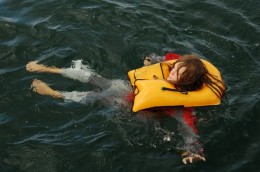
Air bags and seat-belts are all much of a muchness, and they all come in one size. Lifejackets come in a wide variety of styles, sizes, and types; not every lifejacket fits every sailor, and not every lifejacket performs equally well. Moreover, whereas seat belts, etcetera, are rigorously tested in conditions which approximate to those that they may someday face – with simulated head on crashes – lifejackets are tested in a swimming pool. If you feel that this is sufficient… well, you presumably haven’t seen the Solent on a boisterous day, and you certainly haven’t seen the Atlantic.
If you have never been in the water in your lifejacket you probably don’t give its performance much thought. If pressed you would probably say that you expected it to inflate smoothly and roll you onto your back. What you would not expect would be for it to grip you round the throat like a hangman’s noose, float you with your feet in the air, or fail altogether to inflate. That sort of performance would come as a bit of a surprise.
Speaking of surprises, when I researched Kids in the Cockpit I was astonished to find that of the several dozen mothers to whom I spoke only one had actually tested her child’s lifejacket. And this one woman had found that her toddler floated with his feet in the air and his head under the sea. Many other surprising discoveries were also made – but my purpose here is not to recap on what has already been written.
I have always tested my lifejackets. Even as a child I wondered whether the thing really would hold me up – and so I jumped in and found out. Now, I still test my own lifejacket every once in a while, and I regularly test my children’s lifejackets; I test them when they are new, and I test them as the children grow. I test them partly to see if they will still hold the child up in an efficient manner, but also so that the kids remain familiar with the kit. This is important, because statistics apparently show that people who are familiar with their lifejackets are more likely to survive when they use them “for real”.
Just recently we decided that Roxanne ought to go through the ritual again, in order to be safe, and so we popped her into her lifejacket and tossed her over the side. What follows is a summary of our findings.
Roxanne’s lifejacket was a junior version of Crewsaver‘s Crewfit, a gas inflation lifejacket, and a leading brand example of the type popular with yachtsmen all over Europe. For most of us these lifejackets are the only kind worth having, because they are the only kind that an adult is actually going to be bothered to wear. Gas inflation jackets are compact – they don’t get in your way while you are hauling on lines or winding on a winch – and the kind most suited to yotties is fitted with a harness. In the past, when the going got tough we donned our harnesses and hooked on. Now, we don our harnesses and hook on – and the fact that the harness also includes a lifejacket comes as a bonus.
The harness-lifejacket combo was specifically designed for people like us: people who believe that remaining attached to the boat is vastly more important than being able to bob about like a cork. Since we don’t intend parting company with the boat while she remains afloat, we would not be inclined to don a stand-alone lifejacket until matters became critical. By which time it might be too late.
It is worth pointing out that you can very easily die in a lifejacket. You can die of hypothermia. You can die of hypoxia (whereby the coldness of the water operates your gag reflex and closes off your wind-pipe, so denying you oxygen). You can also get run down by the boat which is hurrying to pick you up, and you can even drown, when the waves land in your face and choke you. Thus, the first three rules of safety at sea are:
- Stay aboard.
- Stay aboard.
- Stay aboard.
A decent harness and a strong tether adequately secured to a robust fixing point is a set-up worth any number of lifejackets.
But, in the very end, when you do need a lifejacket, you want the best one that money can buy. Or, at the very least, you want one which does the job.
Which brings us back to our beginning.
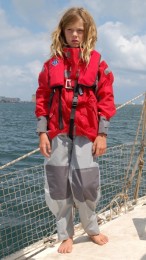
ROXANNE TESTS the JUNIOR CREWFIT
Generally speaking, when testing auto-inflating lifejackets we remove the bottle and the firing mechanism. This is because we are broke. However, bearing in mind that Roxanne could not remember the last time she tested her jacket we decided that for this particular test we must go the whole hog and fork out the £17 for the replacement parts.
Roxanne last tested the auto-inflating aid when she was not quite six years old. That test is described in Kids in the Cockpit, and alongside the account are two photos, one showing the child in the said, 150N gas-inflation aid and the other showing her in a 150N foam-and-air lifejacket. In the second photo she is smiling sweetly at the camera. In the first she is in a state very close to total panic. The Junior Crewfit completely dominated her. It pinned her on her back so that she felt completely helpless – indeed, she was completely helpless. When she drifted under the counter, at the stern of the boat, there was absolutely nothing that she could do about it. She was at the mercy of the sea, and any passing wavelet could leap onto her frightened face and into her open mouth.
In the light of this experiment we put the kiddy-sized auto-inflating aid to the back of the locker, and Roxanne used the aforementioned foam and air lifejacket. But the years have flown by, and Rox has just turned 11. The chunky foam jacket is now regarded with disdain. Clearly it was high time we gave the compact, auto-inflating one a second chance. She put it on, and she made that giant leap into the unknown… Would it hold her up? And if so, which way up? Would the darn thing deign to work at all?
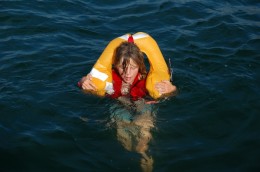
The last time Roxanne performed this same leap, at the age of six, it took two very long, slow seconds for her to reappear at the surface – as I recall it, I was just on the point of thinking about jumping in – but this time she re-appeared instantly. Last time she broke the surface in a panic. This time she broke it yowling: “Oww -w-w. This thing is killing me; it’s trying to hang me!”
[flashvideo filename=/wp-content/uploads/2008/10/vc-1-20080811180059.flv height=360 width=640 title=”Roxanne found the Junior Crewfit very uncomfortable.” /]Rox weighs barely 35kg, and the jacket is rated for bodies of up to 40kg. Nevertheless, although the buoyancy might be adequate, the Junior Crewfit was clearly too small – or at any rate, too tight around the neck – for our ultra-slim, averagely tall, 11 year old. It’s a pity that we didn’t get round to testing it on her when she was 8 or 9. Based on our findings, and on the reports which I have read, I should say that junior auto-inflating jackets are really only suitable for kids aged between 7 and 10. (For further outspoken but well-researched comments on the total unsuitability of this type of lifejacket for smaller children, please refer to chapter one of Kids in the Cockpit.)
The next thing was to try Roxanne in an adult-sized version of the Crewfit.
WE ALL TEST the ADULT-SIZED CREWFIT
Caesar has been wearing an adult-sized 150N Crewfit since he was 12, but at the time when we bought it for him we reckoned – and Crewsaver reckoned – that he was at the lower limits of their size suitability. Roxanne is a year shorter and quite a bit skinnier than her brother was. Despite this, when we tried her in the jacket it was immediately apparent that it was far more suitable than the junior model. It held the child up without throttling her, and although she declined to describe it as comfortable at least it was not causing her pain.
The Adult Crewfit lifejacket is rated by Crewsaver as being suitable for persons from 40kg weight, meaning that Roxanne is actually 5kg too small. This did concern me – I felt that the manufacturers must have some reason for reckoning that the jacket was too big for Our Rox – and so, after the test, I studied the photographs and the film. Roxanne had felt that the bigger Crewfit was a vast improvement over the small one, and so it had seemed, but when I took the time to consider the photographs it was immediately clear that both jackets – the bigger one and the smaller – were in danger of slipping off over her head.
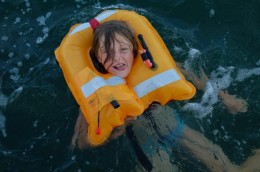
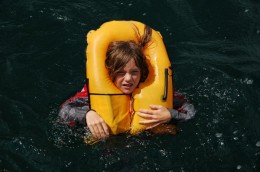
So far as the bigger jacket was concerned, the remedy was perfectly simple: the belt which secures the Crewfit can be passed through one or other of two loops on the wearer’s back, and we had been using the lower loop. When we threaded the belt through the upper loop instead, the position of the air bladder was moved and it now supported Roxanne’s head.
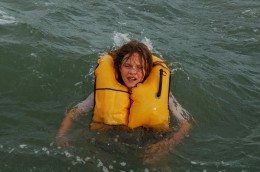
(Note that not all auto-inflating lifejackets can be adjusted in this manner; most have only one belt loop on the back of the harness. Note also that it is not possible to make this adjustment in the water; one needs to have tested the lifejacket, and chosen the best setting, in advance.)
CROTCH STRAPS are a PAIN
Besides finding out which jacket was the more suitable for our 11 year old, we also wanted to try out the crotch straps. Or rather, we wanted to try the lifejackets without crotch straps.
Somebody who knew that he was going to end up in the water might perhaps fit the crotch straps onto his lifejacket, but only a masochist would want to wear them full time. Not only do they look rather kinky, they feel absolutely terrible. Male wearers assure me that two straps are worse than one, offset to one side – and two straps is what you get with a Crewfit lifejacket.
I always used to reckon that if the manufacturers were serious about the need for crotch straps then they would come up with a better design – a “beaver tail”, for instance. Wetsuit jackets often feature a beaver tail. Better still, they might come up with something which allowed us to button the lower edge of the lifejacket onto our oilies, or onto the waistband of a pair of shorts or trousers.
As I say, I always thought that crotch straps were a joke – until I started testing lifejackets on my kids. Then it became perfectly apparent that lifejackets really don’t work efficiently unless there is something holding them down. A bag of air or a bundle of foam does its best to sit on, rather than in, the water. That’s what we want it do; we want it to hoik us up to the surface. But without a crotch strap restraining it, there is far less “hoik” and the jacket makes part of the journey upwards on its own.
Crewsaver are very keen on crotch straps, and so too are Baltic, the well-respected Swedish manufacturer, but the German manufacturer, Secumar, have begun to play them down. Even their top of the range Survival model does not feature a crotch strap as standard. Our recent test provided us with mixed findings. We all jumped in, each in turn, in the same lifejacket, and three out of the five of us found the crotch straps extremely uncomfortable but absolutely vital. The other two hated the straps so much that they released them, and having released them reckoned that they were better able to swim and much more comfortable.
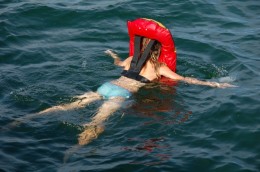
[flashvideo filename=/wp-content/uploads/2008/10/vc-2-20080811181900.flv height=360 width=640 title=”Without the crotch straps the Adult-sized Crewfit was inclined to ride up over Roxanne’s head.
NOTE THAT SHE IS 5kg UNDERWEIGHT FOR THIS JACKET.” /]Once again, the truth of the matter is betrayed by the photographs and the film. The fact is that without the leg straps fitted the jacket floats up, away from the wearer’s chest, and he is supported from under the arms, by the belt. Our two non-conformists both wore the belt very tightly fastened, to try to prevent it from riding up in this way. With the straps fitted the wearer is supported principally from the crotch. No, it isn’t very comfortable – particularly if you are only wearing swimming trunks or a bikini – but it does mean that the buoyancy is kept lower down, hoiking your whole upper body, and not just your head, up to the surface.
[flashvideo filename=/wp-content/uploads/2008/10/vc-3-20080811190156.flv height=360 width=640 title=”Caesar discusses the use of crotch straps.” /]Note that the crew featured in these video clips are the very ones who afterwards said that they preferred not to use the crotch straps!
Three out of the five of us also reckoned that swimming on your front is much easier with the crotch straps fitted and the jacket held down – and I personally rate the ability to swim almost as highly as having the extra buoyancy. As we have seen, unless you can swim in your lifejacket you are helpless. You can’t get back to the mother-ship or towards a ladder or liferaft. It is true that you can always swim on your back, but then you can’t see where you are going; people swimming on their backs generally travel in a circle.
RETRO-FITTING the CROTCH STRAPS
[flashvideo filename=/wp-content/uploads/2008/10/vc-4-20080811193654.flv height=360 width=640 title=”We all found it very easy to “retro-fit” the crotch straps.” /]As part of our recent test we attached the crotch straps to the back of the jacket, in the appropriate place, but left the other end trailing or tucked into a pocket. Would the casualty be able to locate the straps and attach them while he was in the water? The answer is that he would – or at any rate, we all could, and with the greatest of ease. Whether any of us will remember to do so when we take a tumble into the chilly waters of the Southern Ocean is another matter. Cold water has a habit of knocking both the breath and the sense out of an MOB.
ROLL ME OVER
The third thing under test was the self-righting ability of the lifejacket. These 150N jobs are supposed to be able to roll the wearer onto his back – but do they? According to my previous experience, they don’t. I have yet to find a lifejacket which rolls me onto my back. When I mentioned this to one of the manufacturers I was told that 150N jackets sometimes don’t roll the casualty if he/she is wearing oilskins. “For that, you need a 275N jacket.”
But I have only ever tested my lifejacket when wearing swimming things.
As ever, when we conducted this latest test I found that my lifejacket still did not roll me onto my back.
Roxanne was unable to test this feature, because the big jacket held her so well out of the water that she could not immerse her face. On that basis, the Crewfit scored full marks: a jacket which will let you swim and yet still keep your breathing equipment clear of the water is exactly what is needed.
[flashvideo filename=/wp-content/uploads/2008/10/vc-5-20080811185857.flv height=360 width=640 title=”The Crewfit did not roll Caesar…” /]
Caesar, when he was smaller, had the same difficulty as Roxanne in testing the roll-me-over facility of the 150N lifejacket. Now that he is bigger he can easily lie face down in the jacket – and, like me, he found that it did not roll him over.
Then came Nick. Nick hates swimming and in the past he has always disdained to take part in our experiments, but on this occasion his curiosity was aroused. He gave a brilliant demo of a “floater”, drifting about with his head hanging down and his arms and legs dangling, and – lo, and behold – the jacket righted him! Interestingly enough, it didn’t right him in the manner that we had anticipated. It didn’t roll him over sideways; it rolled him backwards.
[flashvideo filename=/wp-content/uploads/2008/10/vc-6-20080811193407.flv height=360 width=640 title=”…but it did roll Nick” /]
We can only assume that the difference in the performance of this one jacket when worn by three different people is a factor of our individual body mass to buoyancy ratio.
Nick is one of those people who floats like a stone. Caesar does not have this problem – when he jumps in, he bobs back up to the surface – and I am so buoyant that in the salty Mar Menor I just about float on top of the water.
Or perhaps the difference was due to our expectations. Since we were expecting to be rolled athwartships, Caesar and I may have been subconsciously positioning our bodies in such a way that the fore and aft roll was inhibited. I have been told that in the not so very distant past lifejackets were tested, by the manufacturers, on people who had been rendered unconscious!
Would a 275 really suit me better?
I think not.
275N lifejackets were originally designed for commercial use – for men working on North Sea oil rigs, and such like – and they have only quite recently been adopted by yachtsmen. The massive bladder of the 275 looks as if it would keep an Olympic butterfly champion pinned on his back, and I have absolutely no doubt that it would roll me, but it is equally clear that it would also prevent me from swimming or climbing aboard a liferaft.
(For a photograph comparing a 150N jacket with a 275N, take a look at the RNLI’s website.)
Once again, the manufacturers’ opinion of 275N lifejackets appears to be divided. Baltic probably sell as many 275s as anybody else – but not to yachtsmen. So far as they are concerned “275s have too much buoyancy for self rescue. You cannot swim in a 275 nor enter a liferaft or climb steps. 275s are for commercial use where organised help should be available.”
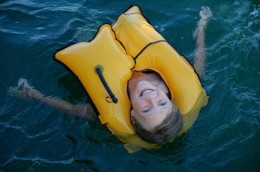 Secumar, on the other hand, hold a completely contrary viewpoint. For them, 275s are the ultimate thing in safety, and they even produce two kiddy-sized 275N jackets. They reckon that “it is always difficult to get into a liferaft. However… if there is an opening which is large enough then it should be possible…”
Secumar, on the other hand, hold a completely contrary viewpoint. For them, 275s are the ultimate thing in safety, and they even produce two kiddy-sized 275N jackets. They reckon that “it is always difficult to get into a liferaft. However… if there is an opening which is large enough then it should be possible…”
One day I mean to get hold of a 275N jacket and find out who is right – but in our next test we will be looking at sprayhoods.

Very interesting article, it’s helped me answer some questions that I’ve been asking myself (and a few others). I’m about to buy four new lifejackets for the family and I was wondering whether to go for the 275N or stick to 150N.
Hullo Pete
I would definitely go for 150N jackets instead of 275s. I think that the manufacturers comments (above) sum up the situation quite clearly.
Protagonists of the 275 say, “Well you can always let out some of the air when you want to swim, or board a liferaft” – but I have my doubts about whether most of us would actually remember to do this in the moment of crisis.
Examination of accident reports suggests that a person who finds himself in the water sometimes forgets even to pull the manual cord and inflate his jacket. (Panicking divers, likewise: they reach the surface in a state of confusion and forget to inflate their BCDs or even to drop their weights.)
I have heard that the RNLI aren’t too happy about 275N jackets, but this may just be a rumour. I can’t find anything negative about 275s on their website. The Yachting Monthly website contains a report which seems to imply that more than one person has drowned whilst wearing a 275N jacket, the problem apparently being caused by the size of the bladder in association with his failure to use the legstraps:
“The crotch strap must be worn. If not, then the vastness of the air bladders in the case of the 275N jacket will cause them to rise up above the wearer, reduce their vision and potentially result in drowning. This has happened on more than one occasion in UK this year.”
I have not been able to find any other reference to these alleged accidents.
Part II of our lifejacket test was performed and written up some months ago – but the MC is under orders to keep his nose in his maths text book, and study for his exams, so it may be some time before it is on line. Since you are about to invest in some new jackets, Pete, I will give you a sneak preview of our findings: essentially, we reckon that a lifejacket without an integral sprayhood is less than half as valuable as a jacket with the hood permanently fitted and easily put into place.
We have not yet found the Perfect Lifejacket, but we have not stopped looking. If any manufacturers are reading this and would like to send us their handiwork for testing we would be very happy to get wet again and to add our input to the latest designs.
Jill
This might be what we are looking for : http://www.ispl.co.uk/news/november_07.htm
It’s called the Challenger Convertible lifejacket, and it’s an automatic 150N which can be converted, by the manual deployment of a second cylinder of gas, into a 275N jacket. When you want to swim, or board the liferaft, you simply pull another toggle and release the air from the secondary bladder.
Presumably anyone who had the wits to remember about the extra bladder would also be sufficiently compos mentis to let the extra air go again when he needed to.
Unfortunately, I haven’t yet found this lifejacket for sale anywhere, and so I don’t know any more about it.
Jill
I think that Mustang may have solve the problem of crotch straps as they have introduced the new LIFT range.
http://www.mustangsurvival.com/lift/index.php
Basically these 180 newton life jackets have an underarm section attached to the air bladder which totally changes the sitting position in the water. The claim to have up to 9 inches freeboard. Very interesting new technology and well worth looking at.
Thanks
SW
I see you don’t monetize your website, don’t waste your traffic,
you can earn extra cash every month. You can use the
best adsense alternative for any type of website (they approve all websites),
for more info simply search in gooogle: boorfe’s tips monetize your
website